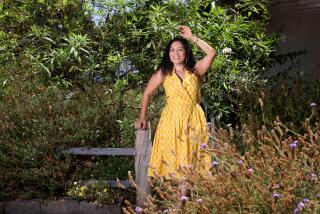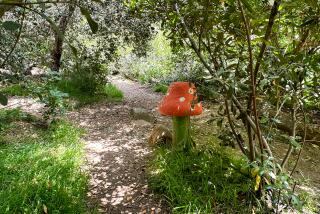Green Thumbs and Greenbacks : Descanso Gardens Guild Now Tends the Books as Well as the Grounds
- Share via
LA CANADA FLINTRIDGE — “God Almighty first planted a garden; and, indeed, it is the purest of human pleasures.”
--Francis Bacon
Essays: Of Gardens, 1625
Bacon, the English philosopher and statesman, could have had someplace like Descanso Gardens in mind when he immortalized those words centuries ago.
Indeed, serene smiles of pleasure tend to play across visitors’ faces as they make their way through the gardens’ expanses today.
A wild baby rabbit, about the size of a human hand, didn’t know that it provided pleasure to a retarded girl who was enchanted by it on a recent morning.
But the members of the garden’s guild know. And they said they took Bacon’s words to heart when they took over administration of the gardens in January from Los Angeles County, which, in a rash of budget cuts, dissolved the Department of Arboreta and Botanical Gardens.
All four county arboreta faced uncertain futures. The Arboretum in Arcadia and the South Coast Botanical Garden in Palos Verdes are now under the auspices of the county Department of Parks and Recreation and could be victims of future budget cuts, depending on the economy.
But seeing the writing on the wall, volunteer guild members of Robinson Garden in Beverly Hills and Descanso Gardens had opted to take over administration of their respective facilities under a five-year contract with the county, which owns the properties.
“There really wasn’t a choice,” said Gail Boatwright, then the Descanso Gardens Guild president, who oversaw the transition.
After the initial shock at the department’s dissolution, Descanso guild members embarked on an act of faith: They had no accounting books from the county to review, Boatwright said, just a few words from Leon Arnold, the now retired chief deputy director for the defunct Department of Arboreta and Botanical Gardens--that they would need to raise about $670,000 in addition to the existing guild budget of about $630,000.
But taking that leap of faith was the only means of survival for this purest of human pleasures. The guild for 40 years served merely as an advisory committee to the county. The nonprofit group raised funds for special projects and managed the gift shop.
But taking the future of the gardens into their hands wasn’t just about preserving its natural aesthetics.
“Don’t you think it restores your soul?” Boatwright said. “There’s a sense of serenity here that you don’t find in parks. Listen to the waterfalls. The sound of water is so soothing.”
Most famous for its camellia and rose gardens, Descanso also features a dozen other plots with themes ranging from the down-home vegetable garden to the more exotic tropical forest. Descanso’s 160 acres also provide a sanctuary for wild birds and animals.
Half the acreage is open to the public; the rest is protected as a natural habitat for California wildlife, said horticulturist Steven M. Cohan, director of Descanso Gardens.
All this provides an oasis for visitors.
“In this urban existence--with the hustle and bustle and the crime--people need this for their mental health,” Boatwright said. “The garden changes people. They are kinder and gentler when they leave.”
Thus, after four months of Angst -ridden meetings last year, the guild took on the financial responsibility in order to provide the gardens “a safer alternative” than the county could, Cohan said.
And at least one person from the county thought the guild could do better.
“They’ve got an active guild and they’ve got the attraction that will bring in the public,” Arnold said. “I don’t think they’ve got any problem at all.”
Cohan maintains the gardens with 14 paid staff members and hundreds of volunteers. During the 1970s, the gardens had a staff of 24.
But the hundreds of thousands of visitors who go to Descanso each year know that it’s there for them to enjoy.
Melissa D’Ambrosi, 14, who is retarded, will never be able to articulate her words of appreciation to volunteer Jean Brato for the walks through the gardens, including the recent morning she saw the rabbit. But Brato, 70, of Los Feliz hears the teen-ager’s loud sighs of joy, sees the sparkle in her eyes and feels her hugs.
Melissa, along with her classmates at Roosevelt School in Pasadena, has been going to the gardens twice a week for years. They are among the many children who go to plant vegetables in the Special Education Garden. Some win prizes for the best tomato or the best lettuce. But best of all, they reap what they sow and feast on their salads.
Melissa can’t work with her friends, but she enjoys the gardens through her walks with Brato. Her face lights up at the sight of a small, wild bunny stealing some greens.
“Ahhhhh,” she says.
“They realize the freedom when they get off the bus,” Brato said. “They express it by patting me and smiling at me. I hug them and I speak to them and let them know that they are wanted.
“You can see how she reacts.”
For most of these children, many of whom live in foster homes, Descanso Gardens is one of the few places they are free to roam. Their parents or guardians often find it difficult to tend to them on public outings, Brato said.
Howard Brown, 81, who often strolls to the gardens from his home nearby, boasts a walking stick he fashioned from a discarded camellia branch. He painted a figure of a snake on it, carved his name and is never without it on his walks. He has also carved a stick for his wife, Catherine, which he has entered in a carver’s contest at the gardens.
“You call it a stick, because you should wear a tuxedo with a cane,” said Brown, a retired building contractor who volunteers at Descanso as a docent. “Walking helps to get rid of my arthritis. I know about 100 times more about the garden than I need” for the garden tours.
Pointing to a large duck in a lake, he said, “That’s a Muscovy, an ugly son of a gun.”
Karen Carr, 37, of Pasadena often visits the gardens on weekends with her two children. Her friend Marla Foxgord of Montrose has frequented the arboretum since she was a girl.
Carr, a teacher, says the only time she gets to enjoy being a mom is at the gardens, where her children can run free. And being a native of Colorado, she appreciates “the greens.”
“It’s peaceful here. You forget that you are living in L.A.,” Carr said. “My husband, Bill, would kill me for saying it because he’s from L.A.”
Foxgord, who baby-sits Carr’s children, says each nook and cranny of the gardens brings back fond memories of her childhood. She wants Carr’s children to experience that too.
And it is for the sake of people such as these--the parents and children, the elderly, the harried executive and the tired commuter--that guild officials believe the gardens should remain always.
So did the gardens’ founder and original owner, E. Manchester Boddy, publisher of the Los Angeles Daily News, who purchased the property in 1937 from the family of the Spanish Army Cpl. Jose Maria Verdugo. Verdugo was deeded what is the gardens and its surrounding 36,000 acres in 1784 from the governor, probably as a reward for loyal service.
Boddy once told his family that he thought he would be remembered more for the garden paradise he built than for his work as a newspaperman. The newspaper, which ceased publication in 1954, is unrelated to today’s Daily News.
Boddy named his estate, which includes a two-story, 22-room mansion, Rancho del Descanso. Descanso means “rest” or “repose” in Spanish.
In 1953, Boddy sold the rancho to the county and Descanso Gardens was opened to the public. Today, with 5,000 members, the Descanso Gardens Guild adopted its first $1.3-million budget as administrators last week for the 1993-94 fiscal year. Under its current budget, the county will contribute about $300,000 this year.
“We are in the black,” Cohan said.
“We’re very happy,” said Sue Beatty, who began her two-year term as guild president in June. “We hope this will stabilize the garden. We are in control of the destiny of the garden. We are absolutely optimistic for the future.”
About 50% of the revenue comes from the county’s funding plus the admission prices, said Lyn Horstemeier, guild treasurer. Admission is $3 for adults; $1.50 for senior citizens and students; 75 cents for children 6 to 12, and free for 5 and younger. Rental of the gardens for weddings and parties, the art gallery proceeds, guild membership dues and donations cover the balance, she said.
To boost annual attendance from the current 175,000 a year to a goal of 500,000, the guild is building a $1.5-million “International Rosarium” rose garden, to be completed next spring. It needs $500,000 for the project, Horstemeier said.
The gardens will also be the venue for concerts and other special events throughout the year as part of a new marketing campaign.
And all of this reaches back to the original relationship between a human being and a garden, said Karen Dardick, Descanso’s publicist.
“Alienation from nature causes fragmentation in society,” she said. “People need to be in harmony with nature.”






